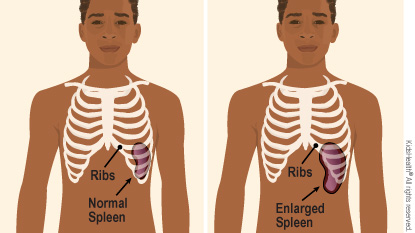Splenic Sequestration
What Is Splenic Sequestration?
Splenic sequestration (SPLIN-ik see-kweh-STRAY-shen) happens when too many blood cells get stuck in the spleen. It is a type of emergency that can happen to people, usually kids, who have sickle cell disease.
Hemoglobin (HEE-muh-glow-bin) is the protein inside red blood cells that carries oxygen. In sickle cell disease, hemoglobin makes the red blood cells pointy, stiff, and sticky. They can get stuck in the spleen’s blood vessels and block blood flow. As blood builds up, the spleen gets enlarged and painful. This buildup also means that too few oxygen-carrying red blood cells are circulating in the blood (anemia).
What Are the Signs & Symptoms of Splenic Sequestration?
The symptoms of splenic sequestration are caused by the spleen getting large and swollen with blood and from severe anemia. Kids with splenic sequestration can have:
- increasing pain on the left side
- severe belly pain or swelling
- a spleen that feels bigger or firmer, or is tender to touch
- fatigue (extreme tiredness)
- dizziness
- a fast heartbeat
- pale skin
- a headache
If your child has sickle cell disease and any of these symptoms, call your hematologist or 911 right away. If you call 911, tell emergency responders that your child has sickle cell disease.
What Causes Splenic Sequestration?
The spleen is a fist-sized organ in the upper left part of the belly that:
- filters germs out of the blood
- filters old, damaged blood cells out of the blood
- makes white blood cells that help the body fight germs
Blood vessels in the spleen have very tight spots where sickled blood cells can get stuck. When this happens, blood flow is blocked in that area. If the blocked area stays small, part of the spleen becomes damaged and scarred. If the blocked area spreads, the spleen can trap many blood cells, leading to splenic sequestration.

How Is Splenic Sequestration Diagnosed?
Doctors usually can diagnose splenic sequestration by asking about a child’s symptoms, doing an exam to feel the size of the spleen, and doing a blood test to check hemoglobin and other blood count levels. Other tests usually aren’t needed. But sometimes doctors will order an ultrasound of the spleen if it is not easy for them to feel it.
How Is Splenic Sequestration Treated?
Kids with splenic sequestration get fluids through an IV, and sometimes red blood cell transfusions. IV fluids help to “flush” the trapped cells out of the spleen. After a transfusion, the new blood cells can carry oxygen to the spleen and the rest of the body. As the spleen gets more oxygen, it releases the trapped blood cells and gets smaller, and the child starts to feel better.
Kids with splenic sequestration should get plenty of rest and avoid bumping or injuring the enlarged spleen, which then could leak a lot of blood.
Can Kids Get Splenic Sequestration More Than Once?
Kids who have had splenic sequestration can get it again. Make sure you and your child know the signs so you can get treatment quickly if this happens. Kids usually have less risk of getting splenic sequestration as they get older. Often an injured spleen will heal, but sometimes doctors might recommend surgery to remove the spleen to prevent splenic sequestration from coming back.
How Can Parents Help?
While your child recovers from splenic sequestration:
- Protect the enlarged spleen from injury. Until the doctor says it’s OK, your child should avoid riding a bike, climbing, rough play, contact sports, heavy lifting, and other activities that could injure the spleen.
- Let your child rest until they feel well enough to do normal activities. It’s OK to go to school when your child has enough energy, and the belly pain is mild or gone.
- Be sure your child drinks plenty of fluids to stay hydrated.
Splenic sequestration is a serious emergency, so take these steps to be prepared:
- Educate. Tell all adult family members, caregivers, and school staff about your child’s risk for splenic sequestration. Be sure they know signs of the condition and what to do if your child has an emergency, and when to call 911.
- Get a medical ID. Consider having your child wear a medical identification (like a bracelet or necklace). It should include your emergency contact information.
- Check the spleen’s size. Your child’s care team will show you how to do this. If it seems to be getting larger or firmer, call them so they can check your child. Keeping track of the spleen’s size can help you spot a problem before it becomes more serious.
